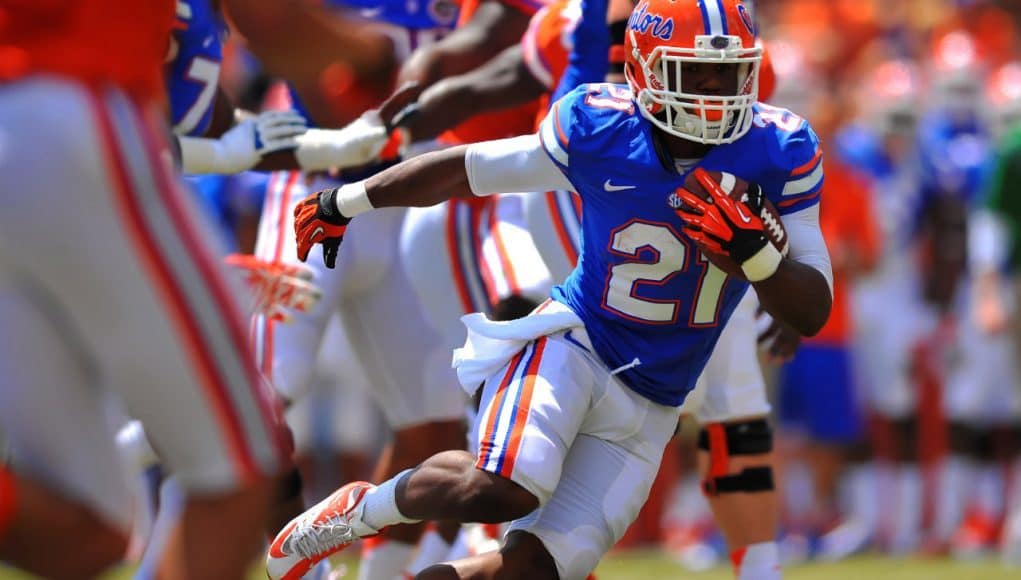Four years ago, Will Muschamp promised to bring a physical pro-style offense to Gainesville and he did just that. Remember the game two years ago against LSU in the Swamp? Florida pounded the ball on the ground, controlled the clock and bullied LSU to hold on to a win at home.
The switch to the pro style offense died following seven consecutive losses to end the 2013 season. Gone was Brent Pease and with him Muschamp’s desire to be a ground and pound type of team.
That doesn’t mean this position will go from being the featured position on offense to a forgotten piece of the puzzle. Gator fans should expect one thing; balance.
In the three seasons Muschamp has been at the helm, Florida has run the ball approximately 62 percent of their offensive snaps. The Gators lowest percentage of running plays was in Muschamp’s first season where Florida ran the ball 469 times in 789 snaps.
During his time at Duke (2008-2013) the Blue Devils threw the ball approximately 54 percent of their snaps and never surpassed 60 percent of totals plays being either a run or pass.
Florida’s deep stable of running backs will still be utilized, just in a different way than they had been the previous three seasons. After being bored to sleep watching the Gators’ offense since Muschamp’s arrival, that might be music to your ears.
The two-deep: Kelvin Taylor (So.), Mack Brown (R-Sr.)
The Rest: Mark Herndon (Jr.), Matt Jones (Jr.), Adam Lane (R-Fr.), Brandon Powell (Fr.)
With Matt Jones still working back to full health, this job is handed over to Kelvin Taylor. The Gator legacy had a productive season and fell just 35 yards short of being the first freshman to lead the Gators in rushing yards since his dad accomplished the feat. Taylor finished with 508 rushing yards, 35 shy of team leader Mack Brown and his 543 rushing yards, despite carrying the ball 37 less times.
Taylor’s skill set fits Roper’s offense well. He’s a one-cut, patient running back and has the moves to make people miss in space. Roper continues to say that he wants to get the ball to playmakers in space and that bodes well for Taylor who can catch the ball out of the backfield as well.
Mack Brown will head into his senior season as the No. 2 running back on the depth chart until we see where Matt Jones is health wise. With Jones’ size, he could also be an option at the “B” position. When he knows who he’s blocking, Jones is more than adequate as a blocker and can also catch the ball coming out of the backfield.
Another player to watch here is freshman running back Brandon Powell. Powell was a late addition to the recruiting class but is the quintessential spread running back. He’s slight in size but makes up for it with his speed and acceleration. Powell is recovering from foot surgery that sidelined him this spring but he did spend the spring watching from the sideline while learning the offense.
Roper’s offense is simple and similar to the spread style that Deerfield Beach High School ran last year with Powell. If Powell can get back up to speed (in the playbook and on the field following surgery) he’s a player to keep an eye on as a potential breakout freshman.
Rounding out the depth chart, Florida has great depth with Mark Herndon and Adam Lane. Herndon carried the ball just four times last season, while Lane redshirted. I wouldn’t expect to see a huge increase for either player with four running backs ahead of them on the depth chart.



I can see Lane becoming a threat in the red zone. One problem with spread offenses is they falter sometimes when the field is restricted in the red zone where you have less space to work with.IHe has yet to take a snap, so this is all just guessing, but I think a small guy that can get low and is built like an a fire hydrant can be hard to even locate, much less tackle. We all know that UF has been one of the worst red zone offenses in the country, maybe Lane willjhelp cure that problem.
That’s not necessarily true. The spread does just that, it spreads the defense out. In the past when Florida would get near the goal line the opposing team would put 11 men and the band in the box and Florida would just run into it.
With a spread offense, you can spread the defense out and potentially create running lanes and a RB one-on-one with a linebacker.